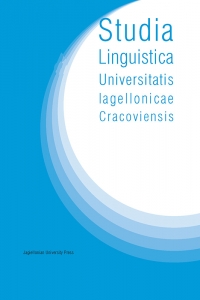The accentuation of balto-slavic vrddhi formations and the origin of the acute
The accentuation of balto-slavic vrddhi formations and the origin of the acute
Author(s): Ranko MatasovićSubject(s): Phonetics / Phonology, Pragmatics, Western Slavic Languages, Eastern Slavic Languages, South Slavic Languages, Baltic Languages, Philology
Published by: Wydawnictwo Uniwersytetu Jagiellońskiego
Keywords: Balto-Slavic Vrddhi; Balto-Slavic accentuation; laryngeals; lengthened grade; Indo-European;
Summary/Abstract: There is still no scholarly consensus about the origin of the Balto-Slavic intonations. The traditional view is that all long vowels and diphthongs receive the acute in Balto-Slavic, while short vowels and diphthongs are circumflexed. On the other hand, according to the Leiden school, the only source of the Balto-Slavic acute is the glottal stop, which is either a reflex of the PIE laryngeals, or of the following glottalized stops (traditional voiced stops) in syllables that underwent Winter’s law. We believe that the traditional view that PIE lengthened grade vowels receive the acute in Balto-Slavic can no longer be defended. It is contradicted by such examples as PIE *dhughtēr ‘daughter’ > Lith. dukth, PIE *(H)rēk-s-o-m ‘I said’ > Croat. rijêh, PIE *hōwyom ‘egg’ > Croat. jâje. It should also be taken as proved that syllables closed by laryngeals and voiced stops (or glottalics, by Winter’s law) received the acute intonation in Balto-Slavic. However, the fact that the PIE lengthened grade long vowels are circumflex in Balto-Slavic does not prove that all lenghtened grade long vowels in Balto-Slavic are circumflex. In the present paper we attempt to show that a number of Vrddhi formations, that were not inherited from PIE, received the acute in Balto-Slavic. These are the words with reflexes in both Baltic and Slavic languages, derived from PIE roots by means of Vrddhi, which remained a productive pattern of derivation during the period of Balto-Slavic unity, and probably later. Such words have the lengthened grade only in Balto-Slavic, but not in other IE languages, which shows that their Vrddhi is not inherited from PIE. This paper systematically analyzes such material in order to show that the Balto-Slavic Vrddhi formations, in contradistinction to the inherited PIE long vowels, received the acute intonation.
Journal: Studia Linguistica Universitatis Iagellonicae Cracoviensis
- Issue Year: 133/2016
- Issue No: 2
- Page Range: 115-123
- Page Count: 9
- Language: English

